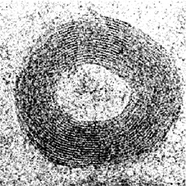Condensation of DNA using poly(amido amine) dendrimers: effect of salt concentration on aggregate morphology†
Abstract
The condensation of DNA and poly(amido amine) dendrimers of generation 1, 2, 4, 6, and 8 has been studied as a function of salt concentration in order to reveal the forces that control the aggregate size and morphology. For the lower generation dendrimers (1, 2, and 4) a dramatic increase in aggregate size occurs as a result of an increase in salt concentration. Toroidal aggregates having an outer diameter of up to several hundreds of nm are observed. For the higher generation 6 dendrimers, the size of the condensed DNA aggregates does not change, however, an alteration in morphology is seen at high salt concentration, as more rod-like aggregates are observed. The size and morphology of generation 8 dendrimers are seemingly insensitive to salt concentration. It is believed that the effective neutralisation of the dendrimer and DNA charge in the aggregate is the reason for the observed effects. It is further shown that the 2D hexagonal lattice spacing observed in toroids is close to constant irrespective of the size of the


 Please wait while we load your content...
Please wait while we load your content...